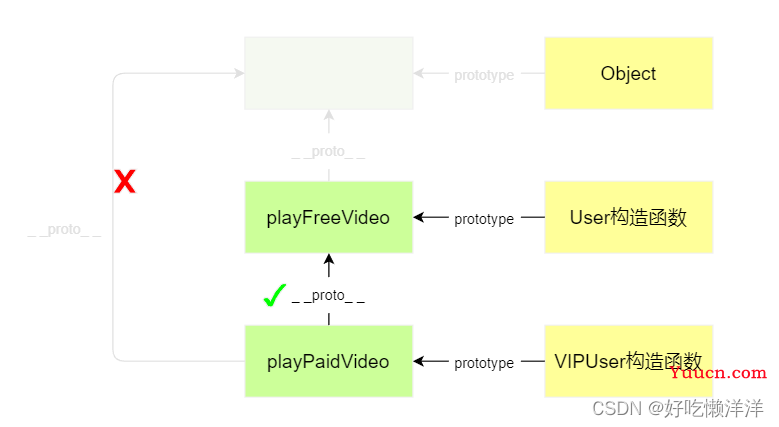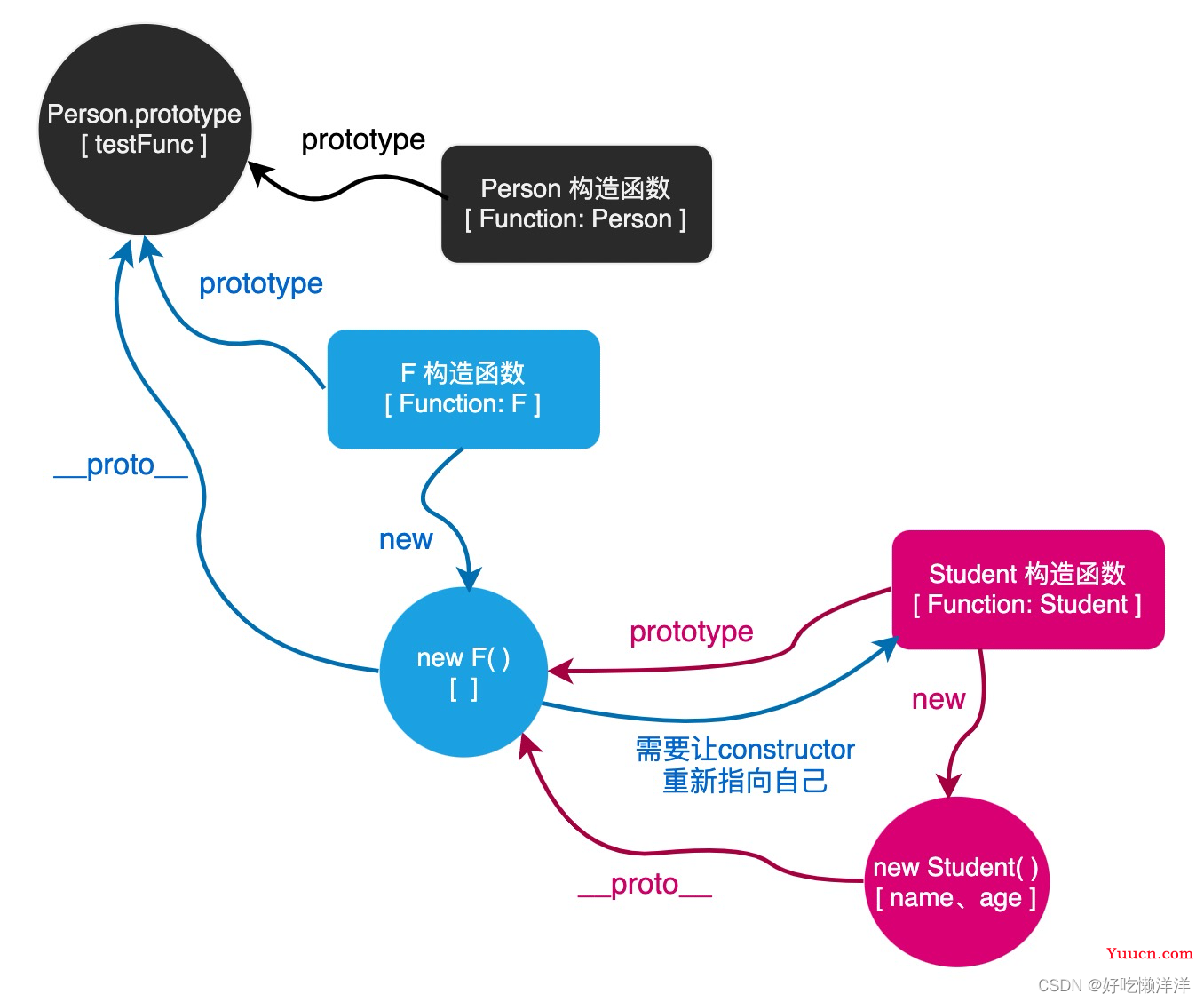
⌚️⌚️⌚️个人格言:时间是亳不留情的,它真使人在自己制造的镜子里照见自己的真相!
📖Git专栏:📑Git篇🔥🔥🔥
📖JavaScript专栏:📑js实用技巧篇,该专栏持续更新中🔥🔥🔥,目的是给大家分享一些常用实用技巧,同时巩固自己的基础,共同进步,欢迎前来交流👀👀👀
👉👉👉你的一键三连是对我的最大支持💙 💜 ❤️
文章目录
- ✔️前言
- 🉐内容
-
- 📗继承
- 📗伪经典模式/圣杯模式
- 📗类语法
- 📕总结
✔️前言
❗️ ❗️ ❗️本篇系将带来JavaScript中的构造——原型——原型链——继承——ES6类语法系列知识完整讲解。 ❗️ ❗️ ❗️
❕上篇涉及:构造——原型——原型链
❕下篇涉及:继承——ES6类语法
🉐内容
📗继承
- 初认识
此处我们就以通常在各种平台所见到的会员与非会员举例:
- 普通会员
属性:用户名、密码
方法:观看免费内容
- VIP会员
属性:普通会员的所有属性、会员失效时间
方法:普通会员的所有方法、观看付费内容
如果我们需要使用构造函数来创建会员,如何书写构造函数才能实现上面的需求?
// 普通会员的构造函数
function User(loginId, loginPwd) {
this.loginId = loginId;
this.loginPwd = loginPwd;
}
User.prototype.playFreeContent = function () {
console.log("观看免费内容");
};
// VIP会员的构造函数
function VIPUser(loginId, loginPwd, expires) {
this.loginId = loginId;
this.loginPwd = loginPwd;
this.expires = expires;
}
VIPUser.prototype.playFreeContent = function () {
console.log("观看免费内容");
};
VIPUser.prototype.playPaidContent = function () {
console.log("观看付费内容");
};
上面的代码出现了两处重复代码:
-
VIPUser的构造函数中包含重复代码
this.loginId = loginId; this.loginPwd = loginPwd;这段代码和User构造函数并没有区别,可以想象得到,将来也不会有区别,即:普通用户该有的属性,VIP用户一定有
-
VIPUser的原型上包含了重复代码
VIPUser.prototype.playFreeContent = function () { console.log("观看免费内容"); };这个方法和User上的同名方法逻辑完全一致,可以想象得到,将来也不会有区别,即:普通用户该有的方法,VIP用户一定有
如何解决上述两处重复?
- 处理构造器内部的重复
可以将VIPUser构造器改写为
function VIPUser(username, password, expires){
User.call(this, username, password);
this.expires = expires;
}
function VIPUser(loginId, loginPwd, expires) {
User.call(this, loginId,loginPwd);
this.expires = expires;
}
- 处理原型上的重复
只需要将原型链设置为下面的结构即可

上面实现仅需一句代码即可:
Object.setPrototypeOf(VIPUser.prototype, User.prototype)
至此,完美的解决了之前提到的两处重复代码的问题
- 这和继承的联系
继承是面向对象的概念,它描述了两个对象类型(类,构造函数)之间的关系
如果在逻辑上可以描述为:A不一定是B,但B一定是A,则:B继承A、A派生B、A是B的父类、B是A的子类。学过后端语言的朋友一定很清楚这是个什么玩意儿
子类的实例应该自动拥有父类的所有成员
JavaScript中,继承具有两个特性:
-
单根性:子类最多只有一个父类
-
传递性:间接父类的成员会传递到子类中
- 如何在JS中封装继承?
function inherit(Child, Parent){
// 在原型链上完成继承
Object.setPrototypeOf(Child.prototype, Parent.prototype);
}
long long ago(开个玩笑啦,也就十多年)…由于没有提供更改隐式原型的方法,因此这一过程会比较复杂。那时候,我们使用一种称之为★圣杯模式★的办法来达到相同的目的,方法如下。
📗伪经典模式/圣杯模式
// 父类
function Person(name, age){
this.name = name;
this.age = age;
}
Person.prototype.sayHello = function(){
console.log("Hello~~");
}
// 接下来我们要继承了
function Student(name, age, gender, score){
// 方法盗用的方式来实现属性的继承(属性)
Person.apply(this,[name, age]);
this.gender = gender;
this.score = score;
}
// 继承方法
Student.prototype = new Person(); // 第一次调用 Person,name 和 age 已经在原型对象上面了
var zhangsan = new Student("张三", 24, "男", 99);// 第二次调用 Person,实例对象上面又回存在一份属性
console.log(zhangsan.name);
console.log(zhangsan.age);
console.log(zhangsan.gender);
console.log(zhangsan.score);
zhangsan.sayHello();
上面这种方式就是组合模式(伪经典模式),但是这种模式也会存在一个缺陷,其缺陷就是属性在实例化对象上面会有一份,在原型对象上面也会有一份,从而造成内存的浪费。
示意图如下:

因此,后面衍生出来了圣杯模式。圣杯模式的核心思想,就是搞一个空函数作为副本。
/**
* @param {*} target 子类
* @param {*} origin 父类
*/
function inherit(target, origin){
function F(){};
F.prototype = origin.prototype;
target.prototype = new F();
target.prototype.constructor = target;
}
// 父类
function Person(name, age){
this.name = name;
this.age = age;
}
Person.prototype.sayHello = function(){
console.log("Hello~~");
}
// 接下来我们要继承了
function Student(name, age, gender, score){
// 方法盗用的方式来实现属性的继承(属性)
Person.apply(this,[name, age]);
this.gender = gender;
this.score = score;
}
// 继承方法
// Student.prototype = new Person();
inherit(Student, Person);
var zhangsan = new Student("张三", 24, "男", 99);
console.log(zhangsan.name);
console.log(zhangsan.age);
console.log(zhangsan.gender);
console.log(zhangsan.score);
zhangsan.sayHello();
⭐️圣杯模式⭐️示意图如下:

📗类语法
ES6之前,函数有着两种调用方式:
function A(){}
A(); // 直接调用
new A(); // 作为构造函数调用
这种做法无法从定义上明确函数的用途,因此,ES6推出了一种全新的语法来书写构造函数
示例1:
// 旧的写法
function User(firstName, lastName) {
this.firstName = firstName;
this.lastName = lastName;
this.fullName = `${firstName}${lastName}`;
}
User.isUser = function () {
console.log("what's up,bro~~");
};
User.prototype.sayHello = function () {
console.log(`sup, my name is ${this.fullName}`);
};
// 新的等效写法
class User {
constructor(firstName, lastName) {
this.firstName = firstName;
this.lastName = lastName;
this.fullName = `${firstName}${lastName}`;
}
// 静态方法
static isUser() {
console.log("what's up,bro~~");
}
// 原型方法
sayHello() {
console.log(`sup, my name is ${this.fullName}`);
}
}
📌示例1主要演示了新的构造函数创建方式,注意其关键字class、constructor、static
示例2:
function Animal(type, name){
this.type = type;
this.name = name;
}
Animal.prototype.intro = function(){
console.log(`I am ${this.type}, my name is ${this.name}`)
}
function Dog(name){
Animal.call(this, '狗', name);
}
Dog.prototype = Object.create(Animal.prototype); // 设置继承关系
// 新的方式
class Animal{
constructor(type, name){
this.type = type;
this.name = name;
}
intro(){
console.log(`I am ${this.type}, my name is ${this.name}`)
}
}
class Dog extends Animal{
constructor(name){
super('狗', name);
}
}// 新的设置继承关系方式
📌示例2主要是为了演示了ES6新的继承方式,注意关键字extends、super
📕总结
本篇系到此结束,希望各位都有所收获,如有文章有不当之处请在评论区交流,谢谢👋👋👋